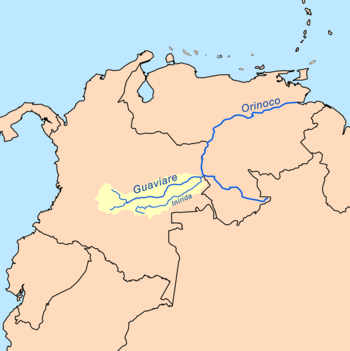Guaviare River facts for kids
Quick facts for kids Guaviare |
|
|---|---|

Guaviare River course
|
|
| Country | Colombia |
| Physical characteristics | |
| Main source | Ariari and Guayabero Rivers |
| River mouth | The Orinoco |
| Length | 1,497 Km (930 miles) |
The Guaviare River is a very important river in Colombia, a country in South America. It is one of the longest rivers in Colombia. The Guaviare River flows into the mighty Orinoco River, which is one of the largest rivers in the world.
This river is like a natural highway, helping people and animals move through the vast Amazon rainforest and the Llanos grasslands. It plays a big role in the lives of many communities and the amazing wildlife that lives along its banks.
Contents
About the Guaviare River
The Guaviare River starts in the central part of Colombia. It is formed when two other rivers, the Ariari River and the Guayabero River, meet. From there, the Guaviare flows mostly eastward. It travels for about 1,497 kilometers (930 miles) before it joins the Orinoco River.
The river's journey takes it through different types of landscapes. It passes through dense rainforests, open grasslands, and areas where the land is flat. This long journey means the river collects water from a huge area, making it wide and powerful.
Where is the Guaviare River?
The Guaviare River is located in the southeastern part of Colombia. It forms a natural border between several Colombian departments, like Meta, Guaviare, and Vichada. These areas are known for their wild and beautiful nature.
The river's path is important for understanding the geography of Colombia. It connects the Andes mountains, where its source rivers begin, to the vast Orinoco basin, which eventually leads to the Atlantic Ocean.
Wildlife and Nature
The areas around the Guaviare River are home to an incredible variety of plants and animals. The river itself is full of different kinds of fish, which are a food source for local people and other animals. Many unique species live in and around the river.
The surrounding rainforests and grasslands are habitats for jaguars, tapirs, capybaras, and many types of monkeys. Colorful birds, like macaws and toucans, fly through the trees. The river also supports reptiles like caimans and anacondas. Protecting this natural environment is very important.
People and the River
For centuries, the Guaviare River has been vital for the people living along its banks. Indigenous communities have lived here for a very long time, relying on the river for food, water, and transportation. They use canoes and small boats to travel and trade.
Today, the river is still used for transport, especially in areas where there are no roads. It helps connect remote towns and villages. Fishing is also an important activity for many families. The river's resources help support the local economy and way of life.
See also
- Río Guaviare para niños (Guaviare River for kids in Spanish)

